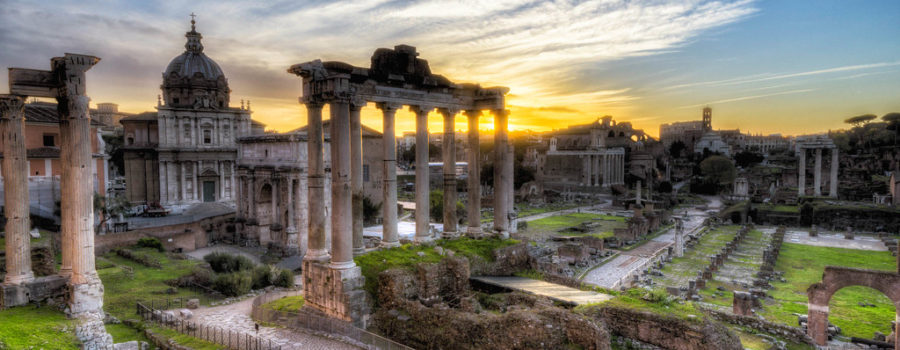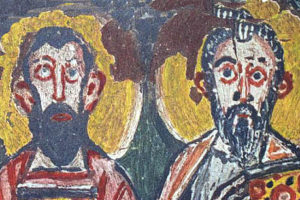Does the body of Saint Peter lie in a crypt below the high altar in St. Peters Basilica in Rome? The view of the Roman Catholic Church is that the Apostle Peter suffered execution in Rome on Vatican Hill where later interred. Historically this position has been both politically and spiritually important.
Catholic scholars perceive the See of Rome holding the keys of the kingdom, passed down from the simple fisherman made chief of the apostles, which his plain grave confirms. This is vital to making the case for the apostolic succession of the bishops of Rome. The position of Catholic scholars, and many others as well, may be seen in the words of German historian Karl Baus.
Baus, as most Catholic scholars, assumes the social and cultural context of early Christianity in Rome is a matter of known tradition preserved by literary means. Writing in the definitive post-Vatican II Catholic work on church history Baus states that:
The basis of the Roman tradition concerning Peter is formed by three pieces of evidence, chronologically close to one another and forming together a statement so positive as practically to amount to historical certainty. (Baus 1990:113.)
These three pieces of evidence which, according to Baus, “clearly” require this understanding are:
- In the noncanonical letter of Clement to Corinth, written ca. CE 100, wherein it author wrote: “Peter, who because of unjust envy suffered tribulations not only once or twice but many times, and thus became a witness and passed on to the place of glory which was his due” (Clement I Clement 5:1-4; 6:1-2, Roberts and Donaldson 1987). From this Baus concludes:
Clement says nothing of the manner and place of Peter’s martyrdom; his omission of such details clearly presupposes in his readers a knowledge of the events; to himself they were no doubt known at first hand, having taken place in the city where he dwelt and within his own time. (Baus 1990:113.)
- Ignatius of Antioch in his letter to Roman Christians, ca. 120 CE, wrote: “I do not command you as Peter and Paul did” (Ignatius Romans 4.3). Baus saw this statement as convincing.He wrote:The weight of this evidence lies in the fact that the knowledge of the Roman congregation about the sojourn of Peter in their midst is unequivocally confirmed by a statement emanating from the distant Christian East. (Baus 1990:114.)
- Lastly, Baus looks to the Ascensio Isaiae. According to Baus the document:
…in its Christian version dates from about the year 100, says, in the style of prophecy, that the community founded by the twelve apostles will be persecuted by Belial, the murder of his mother [Nero], and that one of the Twelve will be delivered into his hands. This prophetic statement is illuminated by a fragment of the “Apocalypse of Peter”, which can also be ascribed to the beginning of the second century. Here it says: “See, Peter, to thee have I revealed and explained all things. Go then into the city of fornication and drink the chalice that I have foretold to thee (Baus 1990:114.)
This theological paradigm, or construct, requires the execution and interment of St. Peter to have been in Rome on Vatican Hill. Baus concludes his argument with:
Even more important is the fact that this tradition was neither claimed for itself by any other Christian community nor opposed nor doubted by any contemporary voice. This almost amazing lack of any rival tradition is without doubt to be regarded as a deciding factor in the critical examination of the Roman tradition. (Baus 1990:115.)
In the last century the archaeologists undertaking the excavations below the ancient basilica of St. Peter’s set about looking for the tomb of Peter at that location for it was “common knowledge” that the apostle Peter was entombed there. The overwhelming traditionF1 of the church fathers held so (see The Tomb of St. Peter by archaeologist Margherita Guarducci (Guarducci 1960). According to Paul Stenhouse the:
Most impressive of the evidence that confirms the scriptural and traditional view that Peter died in Rome, are the archaeological remains under the High Altar of St Peter’s Basilica, and graffiti on St Peter’s tomb and in the Catacombs of St Sebastian on the Appian Way, and in the tombs of the Valerii about 20 metres from the tomb of Peter on the Vatican hill. (Stenhouse 1988:20.)
Their work revealed numerous first-century tombs below St. Peter’s Basilica. A visit to the Vatican Excavations Office will admit one, by appointment, to the excavations. The tour, well worth the time and effort, ends with the visitor encountering the first-century cemetery section, below the high altar in St. Peters, which many believe to be the place of the apostle Peter’s entombment.
This theological predisposition forced a specific meaning on the archaeological data revealed by excavation. The social and cultural context for understanding the data rested on this paradigm. The conceptual model Vatican excavators adopted was a theological one which simply advances the proposition that:
By general consensus Roman Catholic tradition holds that the apostle Peter arrived in Rome, founded the congregation, and continued to reside there serving as its bishop, presiding over the whole Church until his death by martyrdom under Nero, except for visits to the East and to the Holy Land to attend the councils. His martyrdom occurred on Vatican Hill where his followers entombed his body.
Did Peter live and die in Rome?
The question is: does the authentic location of the apostle Peter’s death and interment lie on Vatican Hill? Or, was St Peter really in Rome and if so did he really die there? Loraine Boettner states in his work Roman Catholicism, published by the Presbyterian and Reformed Publishing Company, that “there is in fact no New Testament evidence, nor any historical proof of any kind, that Peter was ever in Rome” (Boettner 1989:117).
The first Vatican excavation commenced with the understanding that the apostle Peter did indeed visit Rome and ultimately meet his death there. The excavators believed that Peter presided, resided, and suffered martyrdom in Rome. The excavation yielded data, specifically graffiti, which were “read” in the sense that they were characterized in tune with this paradigm.
Although the excavations brought to light no grave which could be regarded as the burial-place of the apostles, certain of the graffiti force us to the conclusion that the Christian visitors were convinced that here were the tombs of Peter and Paul. The discovery gave rise to a number of hypotheses, of which none has yet decisively prevailed. (Baus 1990:116.)
The hypotheses for the excavators, and others considering the data, derived from Baus (Baus 1990:116) were:
- The actual burial-place of the apostles Peter and Paul was on the Via Appia, their bodies having been translated to Constantine’s basilicas only after these were built.
- The relics had been brought to St. Sebastians for safety during Valerian’s persecution and had remained there until their translation to the new basilicas.
- Such a translation to the Appian Way, in view of the Roman burial laws which strictly forbad the opening of graves was impossible. A substitute shrine may have been set up on Vatican Hill when the persecution of Valerian made visits to the real tombs impossible.
- There may have been on the Appian Way a center of veneration of the apostles Peter and Paul belonging to some schismatic group such as the Novatians.
The excavators of 1917 favored the first hypothesis. Renewal of the excavations occurred in 1940-1949. One of the finds in area P was an aedicula or tomb to which the builders of Constantine’s basilica oriented the structure. They apparently believed the aedicula to be the tropaion of Gaius, built ca. 160 CE, which tradition held to be immediately above Peter’s grave.
In front of the lower niche a flat stone covered a space about 60 cm square… In the earth beside this there were no actual remains of a grave… It is noteworthy that around this asymmetrically placed square four later graves (g,h,J,t) were so arranged that they would not encroach upon it; one of them (J) can be dated by a tile as being of the time of Vespasian. This leads us to presume that an already existing grave was intentionally left in tact. As all the other graves of the area P show only earth burials, the excavators concluded that it contained none but Christian graves, although no other indications prove their Christian character. The carefully preserved square under the stone of the aedicula is, say the excavators, the place where Peter was buried… The absence of anything that might identify the tomb can be explained by the conditions of emergency, in which Peter had to be buried; its defective state may be due to interference either at the time of a possible removal or some other occasion of which we can know nothing. (Baus 1990:117-118.)
One can only imagine the interplay between the pervasive theological construct with which the excavators worked, attributing find after find to reach the conclusion they desired. This form of reasoning is a hermeneutic circle. The excavators put together an explanation seemingly consistent with the proffered evidence and accounting for the data observed.
Whether this analysis resulted in an accounting for the data and findings, such that its validity rests on a standard of proof requiring it to be at least more probable than not, is doubtful. This kind of reasoning remains unconvincing.
Baus as a careful Catholic scholar, in reflecting on the actual data, holds that difficulties “make it impossible for the present to agree with the opinion that the excavations have with certainty brought to light the tomb of Peter or its original site” (Baus 1990:118).
Shortcomings of the Whole Matter
Vatican excavators, compelled by their own worldview, had to find the grave of St. Peter. Their theological conceptual model controlled the direction of their excavations. Perhaps it was unthinkable in 1949 to not find the grave of St. Peter on Vatican Hill. The shortcomings in such an approach should be obvious. Consider the following:
- I Clement, a highly redacted document, only records that Peter suffered and died without preserving when or where.
- The writings of Ignatius of Antioch remain highly redacted and quite unreliable overall. Even if he actually wrote “I do not command you as Peter and Paul did” it conveys no information about the residential life and death of Peter; but rather, communicates that in fact Ignatius did not possess the authority of the apostle to the circumcision and the apostle to the gentiles to order around the Christian community at Rome or anywhere other than at Antioch of Syria.
- The Ascensio Isaiae comes late, remains mystical, and shows no historic evidence with respect to the issues at hand.
The traditions for St. Peter’s presence at Rome has a high probability of being wishful thinking. In Gadamer’s terms, they failed to respect the distinctiveness of the horizons of the “text,” which in this case consisted of the archaeological record. This episode, despite its good intentions, perpetuated a myth. This is archaeology made to serve religious and political ends. This is understandable, but it illustrates a classic attempt to “use” archaeology to advance a cause—the demonstration of Petrine supremacy. In this case, the utilization of archaeology to prove the traditions of the church, but, archaeology does not prove such traditions, it only proves the exegesis of the archaeologists and their masters.
In 1953, Italian archaeologist Bellarmino Bagatti excavated an ancient cemetery at Dominus flevit in Jerusalem where he found an ossuary dating to the first century CE bearing an unusual Hebrew inscription. It reads tnwy rb wrxmv (Shimon Bar Yonah) translated Simon son of Jonah paralleling the Greek Simw Bariwa of Matthew 16:17. There is some difficulty in discerning the last four characters but they appear to read tnwy (Finegan 1992:368-369). Even though the reading of the last word is uncertain, if this ossuary had been found on Vatican Hill in a first century cemetery, would Catholic scholars inform the world there no longer remains any doubt of Peter’s interment there?
One of the shortcomings of this hermeneutical approach consists of the fact that an exegesis by persons whose ideals favor evolutionary, mythological, theological, technological, ecological, economic or other constructs, resulting in interaction with the data according to these models produces a result that may account for a set or sets of data but at the same time appear absolutely preposterous. A mythological construct can result in a model of space aliens breeding with hominids to produce modern humans. In other words, the hermeneutic methodology may constitute a useful engine for the creation of myths—the buzz words consist of “may be,” “perhaps,” “perchance,” “conceivably”— as well as one for the production of useful knowledge. A danger in hermeneutic analysis consists of its production of misinformation. The impact of such misinformation lies in the devastation it renders by fostering disbelief and distrust of scholarly activity.
There exists no universal means of identifying degrees of validity or reliability in the method. The weakness lies in the standard of proof. Simply improvising an explanation of how something could have occurred does not equate with presenting reliable evidence that it in fact did occur.




Recent Comments